 Leading Blog | Posts by Month |
 Leading Blog | Posts by Month |
11.30.17

LeadershipNow 140: November 2017 Compilation
See more on
Posted by Michael McKinney at 09:10 AM
11.27.17

Find the Fire ... Again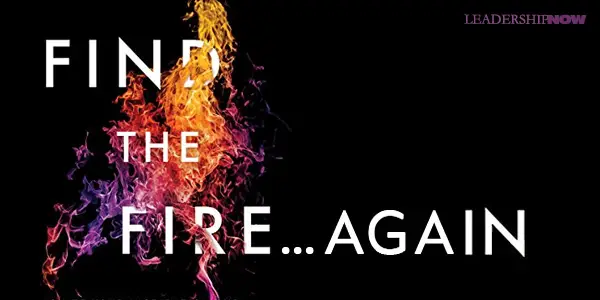
T In Find the Fire, author Scott Mautz says what happens is that we lose control of the process. Most people are overcome by self-defeating beliefs and thought processes. He has identified eight culprits that drain our inspiration and explains how we can counteract them. “You can create the conditions where inspiration is much more likely to occur.” Mautz offers antidotes to the anti-muses as he calls them. The eight anti-muses that we need to keep an eye out for are: Fear
Settling and Boredom
Inundation
Loss of Control
Dwindling Self-Belief
Disconnectedness
Dearth of Creating
Insignificance
Lack of Evocation

Posted by Michael McKinney at 06:11 PM
11.23.17

Unconditional Gratitude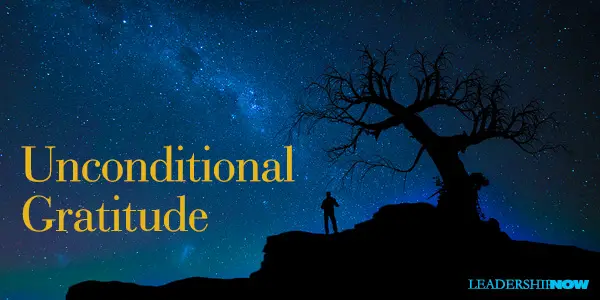
W Autonomy is simply looking at life as though we are a world unto ourselves. As though we did it all by ourselves. It’s pride. But the reality is, we are connected. The opposite of autonomy is gratitude. Gratitude isn’t dead, but it is in trouble. Society does not see gratitude as a moral or a character issue, which it certainly is. Although it is has been scientifically proven to be a key to happiness, it is something much more profound than that. Most of our problems—especially relational issues—can be traced back to a lack of gratitude. In dealing with any of our problems, you will find that there is a lack of gratitude over something or someone. The Roman statesman Cicero wrote, “Gratitude is not only the greatest of virtues, but the parent of all others.” Even Adam Smith, the economist that believed that the market should be driven by self-interest, expressed in The Theory of Moral Sentiments, his belief that feelings of gratitude are crucial for maintaining a society that is based on goodwill. He considered gratitude to be a crucial source of social civility and stability. Like all character traits, gratitude is expressed in action. It is returning a favor, giving thanks, showing appreciation or simply giving someone your time and attention. Cicero said, “There is no duty more indispensable than that of returning a kindness.” Ingratitude has been called the “essence of vileness” and “the most horrible and unnatural crime that a person is capable of committing.” It is a moral issue that impacts our lives and thinking in significant ways. When we are full of pride, angry, frustrated, depressed, defensive, stressed, irritated or anxious, we would do well take a time-out and uncover our ungratefulness. Gratitude is most often expressed by simply thanking others, but it is more than just giving thanks. It is a way of looking at life; a way of seeing other people. It is more than a strategy or a technique to influence others. It is a way of being. We shouldn’t think of gratitude as something that happens at certain moments throughout our life. Real gratitude doesn’t appear at moments in our life, but it is a disposition we have towards life. Real gratitude is unconditional. Gratitude endures through everything. It is not a fleeting response to our circumstances. You may remember Blanch Dubois’s classic statement in Tennessee Williams play A Streetcar Named Desire, where she said that she always depended on “the kindness of strangers”—people she didn’t know and may never see again. It was not about individual episodes in her life, but rather it speaks to a perspective on life. It’s not just gratefulness to a person but a gratefulness for your existence and how far you’ve come. It’s being aware of your whole life. An awareness of how much we owe to others throughout our life. Gratitude creates perspective. Gratitude says, “I’m part of something bigger. I am not alone.” It connects us with each other. It strengthens our relationships while moderating our behavior. The autonomous person rejects gratitude precisely because they must recognize and submit to others in this way. They think, “If I can find something wrong with that person I don’t have to recognize their kindness. I can invalidate them.” The autonomous don’t want to recognize others so that they can justify treating them any way they want. This kind of thinking is not based in reality. Eventually, it leads to self-destruction. Gratefulness changes us. It strips away our indifference. It puts us in touch with reality because it acknowledges our connections—our networked existence. It is this gratitude effect—the way it grounds us in reality—that benefits us and those around us the most. Gratitude moderates and even inhibits toxic emotions but more than that, it gives birth to positive emotions. It’s why Cicero said that it was the parent of all of the other virtues. Gratitude gives birth to and nurtures patience, a sense of humor, curiosity, creativity, insight, kindness, respect, courage, generosity, empathy, and positivity to name a few. Gratitude creates the space for positive emotions to grow and flourish. Anger, irritation, defensiveness, worry, and impatience, are choices. These emotions don’t happen to us; we choose them. Have you ever been in the middle of an angry rant when the phone rings? When you answer the call you are all “sugar and spice and everything nice.” When it’s over you go right back into your angry rant. It’s a choice. The point is, we can choose gratitude to drive these toxic emotions out of our lives. Negative emotions cannot coexist with gratitude. Gratitude has the power to pull teams together. When things don’t go our way, or when people don’t do what we think they should, we tend to pull away—withdraw. We want to take our ball and go home—disengage. If we can develop a mindset of gratitude, that will not happen. We will stay engaged. We will work together. Gratitude has the power to slow us down and reflect and refocus our attention on what matters. Sometimes we have to step back to see our life in perspective; to be able to connect the dots. I like the way American writer Ursula Le Guin put it: “If you can see a thing whole—it seems that it’s always beautiful. Planets, lives. …But close up a world’s all dirt and rocks. And day to day, life’s a hard job, you get tired, you lose the pattern.” It’s easy for any of us to lose the pattern, to lose the narrative, to forget what we are doing this all for if we never step back and see the bigger picture with gratitude. How do we get to the point where gratitude defines who we are?
Gratitude is humility in action. Not surprisingly, the mechanism behind gratitude is remembering. Developing a mindset of gratitude is about remembering. We don’t come by gratitude naturally. It’s not common sense. It’s something we have to cultivate. And remembering takes effort. Of course, we can find the differences; we can find the negative. We can dwell on it. It’s the core trait of a toxic individual. But we can combat that by seeking out anything that is excellent or praiseworthy—seeking out the good in any situation. Drawing upon positive memories gives us hope for the future. Unconditional gratitude heals and creates understanding and builds relationships. Gratitude acknowledges that we are connected. Allow unconditional gratitude to define you as a leader.
Posted by Michael McKinney at 07:40 AM
11.20.17

8 Ways To Design a High-Trust Culture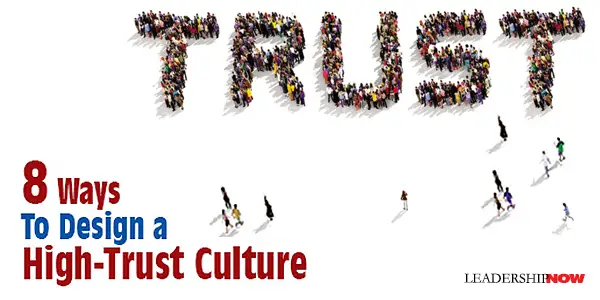
T Zak says that the most important thing to know is that “oxytocin works by activating a brain network that makes us more empathic.” He calls oxytocin “the moral molecule because when the brain releases it, we treat others well.” High levels of stress and testosterone inhibit the release of oxytocin. But here’s the good news. “You can actively promote oxytocin release and capture its benefits, including increased interpersonal trust and improved health, by modifying your default social behaviors.” Competition and status increases testosterone in both men and women. (Men have five to ten times more testosterone than women.) Promotion? Hot new romantic partner? Large bonus? “Testosterone whispers to our brains that we have won the social lottery and make us behave like demigods. It also increases libido. No surprise that CEOs, presidents, and movie stars have affairs.” Putting a check on your behavior will help you to produce a high-trust culture. Neuroscience has affirmed eight factors that are the building blocks of organizational trust. Zak has labeled these eight ways around the acronym OXYTOCIN. Ovation is recognizing colleagues who contribute to the organization’s success. Ovation should be unexpected, tangible, and personal. It should also be close in time (no more than a week), consistent, and done publically. eXpectation is setting difficult but achievable eXpectations. It engages the brain’s reward system, so that meeting goals at work becomes highly engaging and enjoyable. Challenging stress is good for you. Regular feedback on performance builds neural pathways in the brain that adapt behavior to meet goals. Yield means leaders must let go. Empower people to share their expertise and allow them to choose how to do projects. Instigate innovation by encouraging mistakes with limited downside and reward employees who make them. Train extensively and delegate generously. Transfer supports autonomy. Enables self-management by permitting colleagues to craft their own jobs. Facilitate self-mastery and skill development. Advise between teams without dictating. For transfer or self-management to be effective, Ovation, eXpectation, and Yield must be present in the organization. Openness involves keeping others informed. Sharing information broadly with colleagues and additionally, soliciting input and valuing the input of others. Organizational trust occurs when decisions are transparent, and reasons for decisions are shared. Caring is intentionally building relationships and prioritizing empathy. Supporting others. Letting people take the time to get to know each other increases trust. Emotions are recognized and accepted. Sometimes “difficult” people just need to be recognized and shown care. Peter Drucker said, “The number one practical competency for success in life and work is empathy.” Invest is committing to “whole person” development and work-life integration. Although it provides the foundation for a long-term commitment to the organization, investing in people is quite often just an afterthought. Do a Whole Person Review that asks three questions: Are you growing professionally? (Am I helping you to get your next job?) Are you growing personally? (Are you and your family happy?) Are you growing spiritually? (Are you developing as a human being?) Natural is allowing leaders and colleagues to be human, honest, and vulnerable. Ask for feedback on a daily or weekly basis. “A natural leader is one who accepts responsibility for mistakes and includes others in wins, who know the organization at every level, from the front lines to the executive suite.” Work the front lines at least one day a month. Trust when coupled with purpose results in joy at work. Working in a high-trust culture modestly increases joy. “Organizations should not try to make people happy at work. Joy is the result of working with trusted colleagues who have a transcendent purpose.” Joy=Trust x Purpose. Does your organization have a high-trust, high-performance culture? You can take the brief 16-question Ofactor Pulse & find out for sure. 
Posted by Michael McKinney at 07:43 AM
11.17.17

4th and Goal Every Day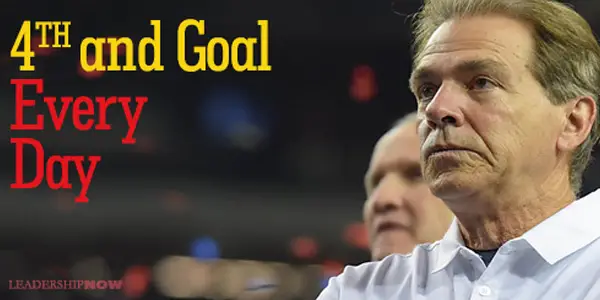
O The secret is that it is fourth and goal every day. Phil Savage of the Crimson Tide Sports Network, explains in 4th and Goal Every Day: Alabama's Relentless Pursuit of Perfection, “Alabama goes for it. Alabama wins more than anyone else because it is 4th and goal to these people in Crimson every practice, every meeting, every game, every day. Do not underestimate the power of that mindset.” When they find themselves in a chaotic game situation, Alabama is prepared because, as they say, “We played this game four times already this week.” You play the game the way you practice, says Saban. Daily urgency is core to the Alabama program. Saban is concerned about the details—the fundamentals. “The fundamentals and practice regimen require players to play to a standard. They do not play to the level of their opponent. They play to a standard set by Nick Saban and established by the team leaders.” Linebacker Dillon Lee said, “We would go in the game and everyone just feels like we played this game. It’s not going to be more physical than practice, it’s not going to be harder than practice. Everything will be slower, based off how we practiced.” Phil Savage says these are life lessons being taught on the field. “The Alabama practices reveal the grit in their players, one by one. Players learn determination and how to deal with adversity.” He adds, “What parents want to happen after four years is to see that their son came out the other side of the Process with resolve and a will to succeed in life. The parents covet the diploma, but they covet most the work ethic players are taught in practice, the forty-year bargain with Nick Saban, not the four-year deal.” How might some of these concepts play out in your leadership and impact your team or organization? Some more thoughts from Phil Savage and co-author Ray Glier: The Crimson Tide does not just recruit high school players, it evaluates them psychologically to determine if they can fit into the culture. Alabama is a demanding place to play, and the staff will dig in on a prospect and investigate how he handles criticism or being corrected. Mental makeup is important, critical, in recruiting a player. If you are a high school player with all the measurables and you did not get offered by Alabama, look in the mirror. 
Posted by Michael McKinney at 03:01 PM
11.15.17

What Are Good People?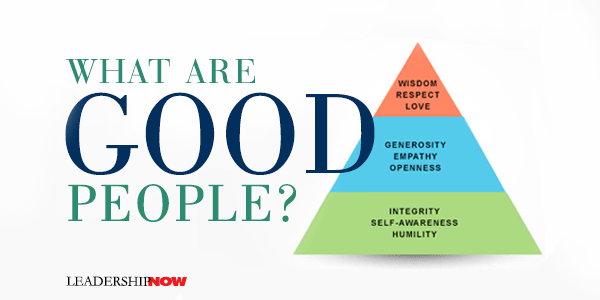
W Anthony Tjan, author of Good People says, “Pursuing goodness in yourself while surrounding yourself with good people is the only leadership decision that really, truly, matters.” Tjan begins a discussion by trying to define good and to build a framework and language to talk about what good is. He defines good people as “those committed to continuously cultivating the values that help them and others become the fullest possible versions of who they are.” He discusses in detail a concept of goodness based on three cornerstone values: Truth: A mindset of humility that makes you teachable. Self-awareness and integrity between your thoughts and actions based on that self-awareness Compassion: An open mind that without bias allows you to understand the actions of others. To practice empathy and act on that empathy with a generous spirit that gives people what they need. Wholeness: Involves gratitude for the people around you that leads to an outgoing concern for others. Caring and nurturing the growth of others. Having the respect to fulfil your obligations to yourself and others and acting with a degree of wisdom. Knowing what is important. As leaders this is easier said than done. Daily we face tensions that have to managed as we try to implement our ideals real. Tjan lists five core tensions:
What can we do? Good people do five things: Good people put people first in their decision making. What does this do to my people? Good people grow by continually seeking to improve themselves and help others to become fuller versions of themselves. While good people value competency, they place a premium on character and values. They commit beyond competency to character and values of truth, compassion, and wholeness. Good people are realists and find the balance between competing priorities and tensions. Learn to balance the tensions that exist in leadership. Good people aren’t situational but seek to do good at all times. Don’t just practice goodness to avoid badness. These five things are the Good People Mantra. They are five promises. As leaders we need to break from our role as leader to follower and relate to others human to human. Goodness come from building it in yourself and inspiring it in others. 
Posted by Michael McKinney at 11:10 PM
11.13.17

The Leadership Triangle
A The elite of higher education would have us believe that leadership can be taught, especially if you are one of the privileged attending classes at a top tier university offering courses in leadership. But there are others who believe leaders come out of the womb with a mission to lead. Either way, we assume that leadership is dependent on personality traits and/or skills. That once a leader, always a leader. But is this the case? Is the population to be divided simply into leaders who always lead and followers who always follow? Leadership is surely more complicated than that. Perhaps the question is not are leaders born or made, but rather, can leadership flourish in anyone when the circumstances for it are right? Does context matter? We tend to remember leaders who seemingly made the impossible possible, but it was always in a particular context. Leaders like Martin Luther King defined by the civil rights movement, Margaret Thatcher defined by the Cold War, and Bill Gates defined by the burgeoning personal computer industry come to mind. For the most part, history doesn’t record how these leaders dealt with contexts outside their defining accomplishments. We examine their leadership and develop theories about their strategies, their skills, and their personality traits. But to understand a broader view of leadership, we must look beyond these historic figures and observe the anonymous trailblazers in our midst. A different picture of leadership emerges. Hurricane Harvey in Texas demonstrated that “ordinary citizens” can step up to leadership when the situation is ripe for it. CNN captured a video of a local boat owner saying this: “We got eight people that done called for us already. So we’re going to go and get them eight, come on back, and try to save some more.” Crisis leadership in action. The story of Todd Beamer, a sales rep for Oracle, still produces chills in anyone who hears it. He is the young man who called 911 during the hijacking of United Flight 93 on 9/11 and declared, “Let’s roll” as he and presumably a few others commandeered the airplane to prevent the hijackers from achieving their goal. They were willing to die for it. Ordinary citizen leadership, however, need not be all about saving lives. Often it is about changing the status quo. Take Sheryl Sandberg, COO at Facebook, who took it upon herself to help women attain leadership roles in business, wrote a book about how to do it, Lean In, and started a foundation to promote it, Leanin.org. This was not part of her job. I’ve had the opportunity in my life to interact and work with some of the most impactful leaders in their fields. Among them is Steve Jobs who returned to the company he co-founded after being ousted in 1985 having learned how to deal with adversity and turned it around with a vengeance. Audrey Rust gathered steam from a passionate group of homeowners in Woodside, California, who wanted to protect the natural beauty in the expanse beyond their backyards and preserved 53,000 acres in Santa Clara, San Mateo, and Santa Cruz counties under her leadership of the Peninsula Open Space Trust. And Walter Isaacson, having established himself as a talented journalist and media professional in the business world, took the reins of the Aspen Institute during a period of severe decline and redefined it as a purveyor of rich and varied content for the intellectually inclined. Certainly, all of these people led others to fulfill a very particular mission and in so doing, created something out of nothing, something that made a difference in the world. But their leadership occurred in a particular context where their competence was significant, their confidence secure and their commitment established. The truth is, leadership is all around us, and it arises within a certain context in which the leader’s ability (competence) aligns with faith of accomplishment (confidence) and forms a mission (commitment). I call this the Leadership Triangle. So rather than ask if leaders are born or made, perhaps we should change the paradigm of leadership examination. Perhaps we have given short shrift in leadership study to the myriad people who find their competence, confidence, and commitment aligning with a particular context and jump in with both feet because there is simply no other choice but to lead.  An entrepreneur at the forefront of marketing, branding, positioning and communicating “The Next Big Thing,” Andy has played a key role in the launch of a number of new technology categories and products (including the Apple Macintosh) over the past 35 years. Today she advises startups, serves on several corporate boards, is a Henry Crown Fellow and a trustee at the Aspen Institute. She is a graduate of Northwestern University and lives in Sausalito on an old wooden boat with her husband, Rand Siegfried. For more information, please visit get2aha.com and follow Andy on Twitter 
Posted by Michael McKinney at 07:34 AM
11.10.17

The Making of Theodore Roosevelt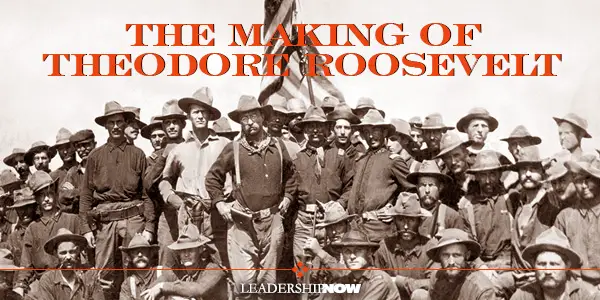
T How Roosevelt became the leader we remember is a remarkable story. His journey is skillfully told in Theodore Roosevelt and the Making of American Leadership by Jon Knokey. Using many unpublished letters and notes from Roosevelt’s contemporaries, Knokey insightfully chronicles TR’s journey to the White House. Theodore was born small and frail. He had life-threatening attacks of asthma as a child, and it consumed the family. “Though driven by good intentions, this over-protection could very well have been the root cause of Roosevelt’s overpowering sense of entitlement. The man needed to be at the center of attention for everything he undertook.” When the Civil War came, Roosevelt’s house was divided too. His father Theodore Sr. was a Lincoln Republican and his mother Mittie, was a Southerner. To keep peace in the family, Theodore Sr. limited himself to noncombatant work with the Union Army while his mother’s relatives fought heroically. Observing his relative’s deeds and his father’s principles and morality, Theodore wrote that, “I felt a great admiration for men who were fearless and who could hold their own in the world, and I had a great desire to be like them.” Knokey notes, “He embraced both contrasts seamlessly, almost naturally. And it was this ability—to embrace contradiction among diverse groups of people—that would become, over time, one of his greatest strengths as a leader.” When he was about twelve, he decided to beat his affliction through strenuous activity. His father told him, “Theodore, you have the mind, but you have not the body, and without the help of the body, the mind cannot go as far as it should. You must make your body.” And he did. Theodore was a curious man. One classmate said, “Never have I seen or read of a man with such an amazing array of interests.” The stores told here of his days at Harvard are revealing. After Harvard, Theodore headed for the New York State Assembly and tried to change the world from day one. He learned he could not and some valuable leadership lessons along the way. “Theodore needed to focus on incremental victories; instead he tried to change the entire culture overnight.” He learned, “It cannot be done by charging ahead alone, simply espousing virtues.”  With the coming of the Spanish-American War, Theodore’s lessons begin to serve him well. “Theodore’s greatest leadership feat, and much more impressive than his charge on San Juan Heights, was that he understood where his followers were, and he led them from there.” He earned his leadership with his men by serving them. On March 4th, 1901 he became President McKinley’s Vice President. Following McKinley's assassination in September, Roosevelt became president and served two terms. Knokey concludes, Theodore “led by downplaying differences, focusing on inclusiveness—focusing on the greater good for all Americans. This made him genuine to the masses. He would fight for anyone, so long as that person worked hard, did their part, had character.” Knokey’s telling of Theodore Roosevelt’s leadership journey is an inspiring one. It is well told, and the anecdotes and accounts from TR’s contemporaries add much to the story. By the end of the book, you will feel like you know the man. A friend of TR’s recalled, “He had the virtues we like to call American, and he had the faults. He knew us, and we knew him.”

Posted by Michael McKinney at 07:29 AM
11.08.17

Let’s Go Invent Tomorrow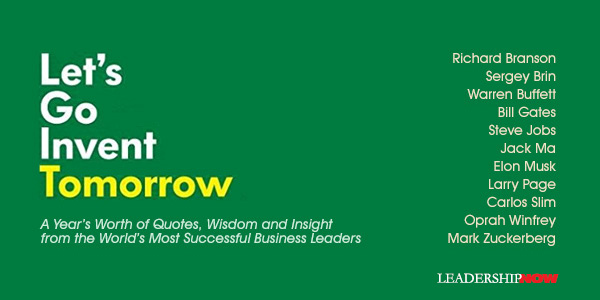
L Some are inspiring, and most are thought-provoking. You won’t agree with every opinion expressed, but you will gain a wider perspective to enhance your own. These successful business leaders share what worked and what didn’t work and more importantly how they approach their work. From Oprah Winfrey’s advice, “The key is not to worry about being successful but to instead work toward being significant—and the success will naturally follow. How can you serve your way to greatness?” to Warren Buffet’s advice on marriage, “Marry the right person. And I’m serious about that. It will make more difference in your life. It will change your aspiration, all kinds of things. It’s enormously important who you marry,” you will find insights to help you build a firmer foundation to grow from. 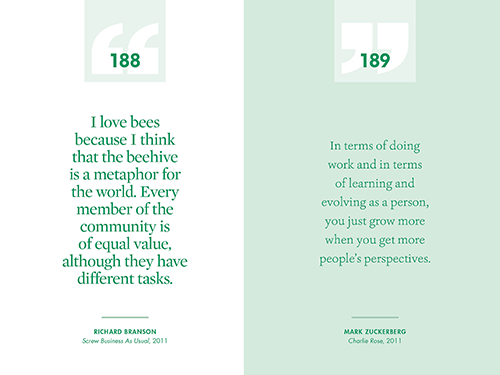 Gary Saul Morson wrote in The Words of Others: “Anatole France frankly advised, ‘When a thing has been said and said well, have no scruple. Take it and copy it.’ Yes, indeed, but do more. Copy many well-said things. Pierce them together. Assimilate them. Make the process of reading them a way to form the mind and shape the soul. As anthologies can never be complete, we will never exhaust the ways quotations can enrich our lives.” Let’s Go Invent Tomorrow will help “form the mind and shape the soul.” 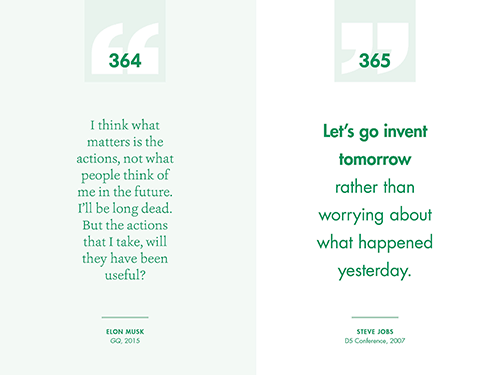 
Posted by Michael McKinney at 08:04 AM
11.06.17

Shake it Off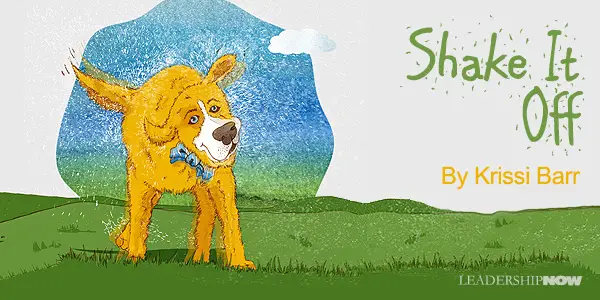
I Well you’re about to get a leadership lesson from a dog. This is not a typo. Dogs are naturals at exhibiting the leadership they need to be the leader of the pack. And they are the masters at shaking things off. Ever watch a dripping wet dog as it gets out of a pool or a lake? Once it’s on dry land it just shakes it off. No towel or hairdryer needed, just a hypnotic back and forth motion that sprays unwanted water in every direction. And when it’s done the dog just moves on as if nothing ever happened. At work, we need to learn how to do the same. Many of us make mountains out of molehills. Instead, we need to practice how to shake things off. After all, that little jab about your new mullet hairdo was meant as a good-natured joke. Heck, they’re probably jealous of your smokin’ hot new Billy Ray Cyrus look. So how do you shake off these little things at work? Pivot from what you don’t want to what you do want. Trust in others’ positive intentions. It is overwhelmingly more likely that your co-worker is not out to undermine you. So if they jab you for the way you did a project, take it as a learning experience. Pivot to how you can do better the next time. If you’re on the receiving end of a mean-spirited joke, talk privately with the perpetrator. Pivot to what you want—a good relationship—and let them know how their comments made you feel. Leaders speak truth to power, but in a way that helps everyone come out a winner. If you’re the leader of a team or office you also need to create an environment where everyone feels happy at work. If you see someone who is not able to shake things off, step in and make things right. Don’t allow the inmates to run the asylum. Great leaders set the right tone. They show their team how they pivot from the negative—“we lost a good customer”—to the positive—“let’s redouble our efforts to learn from that and win a new customer.” Leaders don’t allow the little things to get under their skin. There are, of course, some things that we should not shrug off. Constructive criticism, safety concerns and feedback on company policy can be critical to our success within the organization. These big issues are valid and require our buy-in. It’s easy to wallow in misery. If you find the right compatriots you can wail and moan for weeks or years. But it won’t do you any good. Take a leadership lesson from a dog. Pivot from what you don’t want to what you do want. And shake it off.  
Posted by Michael McKinney at 07:28 AM
11.03.17

Leadership Forged In Crisis
L It is a misconception of leadership that if you engage in the best practices of a great leader, you will become that leader. Applying the idea that if I do this or if I have this quality I will become a great leader like my chosen mentor, can derail your leadership development. That said, there are principles you can discover that if adhered to will propel you in the right direction. Harvard professor Nancy Koehn illuminates some of these principles for us in Forged in Crisis as seen through the lives of five exemplary leaders: polar explorer Ernest Shackleton, President Abraham Lincoln, legendary abolitionist Frederick Douglass, Nazi-resisting clergyman Dietrich Bonhoeffer, and environmental crusader Rachel Carson. These principles set the stage for leadership effectiveness, but the decision to step into leadership is yours alone. Koehn borrows from David Foster Wallace and defines an effective leader as one “who can help us overcome the limitations of our own individual laziness and selfishness and weakness and fear and get us to do better, harder things than we can get ourselves to do on our own.” Coach Tom Landry said it this way: “Leadership is getting someone to do what they don't want to do, to achieve what they want to achieve.” Henry Kissinger said, “The task of the leader is to get his people from where they are to where they have not been." It is intentional influence. But the ability to do that doesn’t come to us naturally. We have to work at it. But that’s good news. We can all get there. Leaders are not born, they are forged. Each of the leaders Koehn has chosen faced an uncertain outcome in the midst of a crisis. Shackleton was marooned on an Antarctic ice floe trying to bring his men home alive; Lincoln was on the verge of seeing the Union collapse even as he tried to save it; escaped slave Douglass faced possible capture while wanting to free black Americans held in slavery; Bonhoeffer was agonizing over how to counter absolute evil with faith while imprisoned by the Gestapo; Carson raced against the cancer ravaging her to finish her book Silent Spring, in a bid to save the planet. The crisis that can break one person can give birth to leadership in another. It’s a conscious choice to lead. Koehn brings out key lessons common to these people as they struggled with their thoughts in what were do or die situations. Here are some of the lessons that we should all take to heart: They Were Made, Not Born These leaders “were made into effective leaders as they walked their respective paths, tried to understand what was happening around them, and encountered failure and disappointment.” They Were Ambitious but… “The drive to make their respective marks was important in shaping them. It took each of them some of the way. But then, interestingly, ambition ceased to motivate and influence them as it once had. As they discovered a larger purpose and embraced it, each found his or her impetus, strength, and validation in the mission itself.” And importantly, Koehn adds, that “their leadership was partly shaped by a willingness to subordinate personal drive in a broader end, one inexorably linked with service to others.” They Did the Inner Work of Leadership They all worked on themselves, looking for opportunities to grow. “They did not do this as a single endeavor, but rather as a lifelong project in which they each kept working on themselves, learning specific lessons, developing more resilience, and using these resources to lead more effectively.” (“Lincoln would have been flummoxed by talk of authentic leadership when he told a few constituents in 1862 that he did not have the luxury of publically expressing his disappointment about Union army defeats.”) They Understood the Importance of Solitude These leaders learned to detach themselves from the situation in order to see things from different perspectives. They “learned how to step back from a specific instant, assess the larger landscape, take the measure of their own emotions, and only then make a decision about what, if anything, they wanted to do.” Reflection and solitude helped them stay focused on the big picture. They Learned to Manage Their Emotions In dark moments, what Bonhoeffer called a “boundary situation,” they determined to manage their emotions. It was not willful blindness or forced optimism. They knew what they were up against. “Because they did, they used their emotional awareness and discipline to concentrate directly, almost exclusively, on how to move forward, how to take the next step, however small.” These people realized that “the emotional penetrability they experienced and that caused them so much suffering was also a door into new insights about themselves and new ways of being in the world.” They Learned to Respond Rather Than to React “At times, doing nothing at all was the best action each of these leaders could take. Time and time again as president, [Lincoln] refused to be goaded by the force of his own emotions or of those around him into taking precipitate action that might compromise his larger mission. Even when he was at his most frustrated, he managed somehow to acknowledge his feelings without acting on them in a way that was destructive to larger matters.” They Were Resilient Though these leaders didn’t always see a way through in the heat of the moment, “they vowed to find a way through the obstacles they confronted. They came out the other side of calamity without falling through the floorboards of doubt, without giving up on their mission and themselves.” All five leaders were well chosen because of their humanity. They were not born leaders. They became leaders through successes, but mostly through failures and mistakes. Leaders can come from anywhere. As we look around the world today, if we are looking for larger-than-life heroes, we misunderstand what leadership is. Although these leaders appear to be larger than life to us now, as you read their stories you see that they are you and me. They are ordinary people in turbulent and trying circumstances. They were often overwhelmed and depressed, but they kept moving on. What distinguishes these people from many of the leaders we see today is their approach to the experiences of their lives. Throughout their lives, they purposefully extracted the lessons they needed to grow. It was thoughtful and intentional. If you go through life any other way, you are just collecting experiences to no end. Experiences alone ensure nothing. We must reflect on them to gain insights and learn from them. All of the lessons these leaders learned are relevant to any leader in any situation. There are no hacks to effective leadership, and you won’t find them here. You will find well-told accounts of these leader’s lives that will inspire and inform your own leadership. 
Posted by Michael McKinney at 08:06 AM
11.01.17

First Look: Leadership Books for November 2017Here's a look at some of the best leadership books to be released in November.    
For bulk orders call 1-800-423-8273  Build your leadership library with these specials on over 39 titles. All titles are at least 40% off the list price and are available only in limited quantities. "Books are the quietest and most constant of friends; they are the most accessible and wisest of counselors, and the most patient of teachers." — Charles William Eliot
Posted by Michael McKinney at 07:37 AM
|
BUILD YOUR KNOWLEDGE


How to Do Your Start-Up Right STRAIGHT TALK FOR START-UPS 
Grow Your Leadership Skills NEW AND UPCOMING LEADERSHIP BOOKS 
Leadership Minute BITE-SIZE CONCEPTS YOU CAN CHEW ON 
Classic Leadership Books BOOKS TO READ BEFORE YOU LEAD |
|